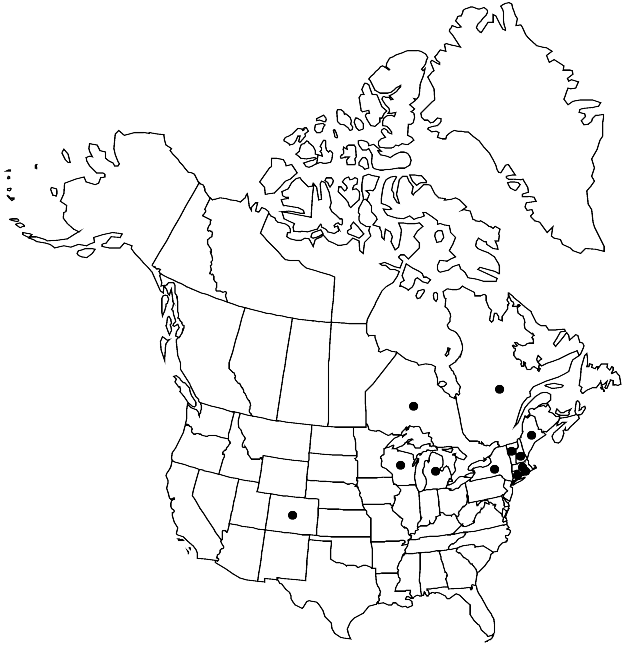Barbarea stricta
in W. S. J. G. von Besser, Enum. Pl., 72. 1821.
Biennials or perennials; mostly glabrous, except blade auricles ciliate or sparsely pubescent. Stems 2–7.5 (–10) dm. Basal leaves: petiole (1–) 2–6 (–9) cm, (sometimes ciliate); blade lyrate-pinnatifid, 1.5–5 (–7) cm, lobes (0 or) 1 or 2 (–4) on each side, lateral lobes oblong or ovate, 0.05–1.5 cm × 1–5 mm, not fleshy, margins entire, terminal lobe 2–7 cm × 10–55 mm. Cauline leaves: blade sometimes lyrate-pinnatifid, lateral lobes 1–3, margins (distalmost) dentate; conspicuously auriculate, auricles ovate or narrowly oblong, (margins entire). Fruiting pedicels erect, 2–4 (–5) mm, terete or subquadrangular, slender (narrower than fruit, glabrous). Flowers: sepals 2–3 × 0.5–1 mm, lateral pair not saccate basally, margins scarious, (glabrous, apex sparsely pubescent to, rarely, glabrescent, subapically sparsely pubescent or, rarely, glabrous); petals yellow, narrowly oblanceolate, 2.5–4.5 × 0.5–1 (–1.2) mm, base attenuate, apex rounded; filaments 2–3.5 mm; anthers 0.5 mm; ovules (16–) 20–28 per ovary; gynophore to 0.5 mm. Fruits erect, appressed to rachis, torulose, terete to subquadrangular, (1.2–) 1.8–2.8 (–3) cm × 1–1.5 mm; style stout or slender, 0.2–1.5 (–2) mm. Seeds brown, somewhat plump, ovoid or oblong, 0.8–1.5 × 0.5–1 mm.
Phenology: Flowering Apr–Jul.
Habitat: Waste places, ditches, riverbanks, damp grasslands, roadsides, fields, disturbed sites
Elevation: 0-1000 m
Distribution

Introduced; Ont., Que., Colo., Conn., Maine, Mass., Mich., N.H., N.Y., R.I., Vt., Wis., Europe, Asia
Discussion
M. L. Fernald (1909) treated some plants of Barbarea stricta as B. vulgaris var. longisiliqua Carion. Although G. A. Mulligan (1978) was the first to record B. stricta for North America, neither his record nor the species was accounted for by R. C. Rollins (1993). Forms of B. vulgaris with fruits appressed to rachis can easily be confused with B. stricta and some forms of B. orthoceras. The latter is separated from both B. stricta and B. vulgaris by having distalmost cauline leaves either pinnatifid or with at least a pair of well-developed lateral lobes. The distalmost leaves in both B. stricta and B. vulgaris have margins entire or obscurely to coarsely dentate. Barbarea stricta has shorter petals (2.5–4.5 mm) and styles (0.2–1.5(–2) mm), strictly erect and straight fruiting pedicels, and sepals and auricles of distalmost leaves often with a few apical hairs. By contrast, B. vulgaris has longer petals [(5–)6–9(–10) mm] and styles [(1–)1.5–3(–3.5) mm], erect or widely spreading and often curved fruiting pedicels, and glabrous sepals and leaf auricles. The boundaries between the two species can be somewhat blurred in parts of New England, and it is not known if hybridization is involved. In that region, plants of B. stricta tend to have slightly longer styles (to 2 mm), and the number of hairs at the auricle apices can be reduced to one and those of the sepals can be absent.
Selected References
None.
Lower Taxa
"elongated" is not a number."thick" is not a number."dm" is not declared as a valid unit of measurement for this property."dm" is not declared as a valid unit of measurement for this property.